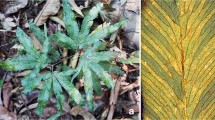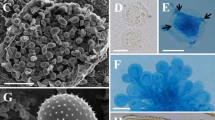Abstract
During field surveys for rust fungi in northeast of China, rust specimens on Galium (Rubiaceae), Aster, and Kalimeris (Compositae) were found in Jilin and Heilongjiang Provinces. Comparative morphology and phylogenetic analyses with 28S and ITS regions of rDNA showed that these specimens belong to Pucciniastrum, although no telial stage was found and they were different to Pucciniastrum species previously reported from the same host genera. Therefore, the rust fungus on Galium and another on Aster and Kalimeris are described as P. coronisporum and P. verruculosum, respectively. Both new species are mainly characterized by having two types of uredinia producing morphologically different urediniospores, which are intermingled in most of the uredinia. Pucciniastrum coronisporum has echinulate and coronate urediniospores, while those of P. verruculosum are echinulate and verrucose to nail-headed.







Similar content being viewed by others
References
Aime MC (2006) Toward resolving family-level relationships in rust fungi (Uredinales). Mycoscience 47:112–122
Aime MC, Bell CD, Wilson AW (2018) Deconstructing the evolutionary complexity between rust fungi (Pucciniales) and their plant hosts. Stud Mycol 89:143–152. https://doi.org/10.1016/j.simyco.2018.02.002
Aime MC, McTaggart AR, Mondo SJ, Duplessis S (2017) Phylegenetics and phylogenomics of rust fungi. Adv Genet 100:267–307. https://doi.org/10.1016/bs.adgen.2017.09.011
Arthur JC (1962) Manual of the rusts in United States and Canada. Hafner Publishing Company, New York
Azbukina ZM (2015) Definitorium fungorum Rossiae, Ordo Pucciniales 1. Dal’nauka, Vladivostok
Cummins GB (1978) Rust fungi on legumes and composites in North America. The University of Arizona Press, Tucson
Cummins GB, Hiratsuka Y (2003) Illustrated genera of rust fungi, Third edn. APS Press, St. Paul
Gardes M, Bruns TD (1993) ITS primers with enhanced specificity for basidiomycetes-application to the identification of mycorrhizae and rusts. Mol Ecol 2:113–118. https://doi.org/10.1111/j.1365-294X.1993.tb00005.x
Gäumann E (1959) Die Rostpilze Mitteleuropas. Buchdruckerei Bucheler Co, Bern
Hall TA (1999) BioEdit: a user-friendly biological sequence alignment editor and analysis program for Windows 95/98/NT. Nucleic Acids Symp Ser 41:95–98
Hiratsuka N (1936) A monograph of the Pucciniastreae. Mem Tottori Agr Coll 4:1–374
Hiratsuka N (1958) Revision of taxonomy of the Pucciniastreae, with special reference to species of the Japanese Archipelago. Mem Fac Agr Tokyo Univ Educ 5:1–167
Hiratsuka N, Kaneko S (1982) A taxonomic revision of Melampsora on willows in Japan. Rept Tottori Mycol Inst (Japan) 20:1–32
Hiratsuka N, Sato S, Katsuya K, Kakishima M, Hiratsuka Y, Kaneko S, Ono Y, Sato T, Harada Y, Hiratsuka T, Nakayama K (1992) The rust flora of Japan. Tsukuba Shuppankai, Tsukuba
Hiratsuka Y, Sato S (1982) Morphology and taxonomy of rust fungi. In: Scott KJ, Chakravorty AK (eds) The rust fungi. Academic Press, London, pp 1–36
Huelsenbeck JP, Ronquist F (2001) MRBAYES: Bayesian inference of phylogenetic trees. Bioinformatics 17:754–755
Ji JX, Wang Q, Li Z, Li Y, Kakishima M (2016) Notes on rust fungi in China 2. Two species of Coleosporium on Composiate. Mycotaxon 131:811–820. https://doi.org/10.5248/131.811
Kaneko S (1981) The species of Coleosporium, the causes of pine needle rusts, in the Japanese Archipelago. Rept Tottori Mycol Inst (Japan) 19:1–159
Lee SK, Kakishima M (1999) Aeciospore surface structures of Gymnosporangium and Roestelia (Uredinales). Mycoscience 40:109–120
McTaggart AR, Aime MC (2017) The species of Coleosporium (Pucciniales) on Solidago in North America. Fungal Biol 122:800–809. https://doi.org/10.1016/j.funbio.2018.04.007
O’Donnell K (1993) Fusarium and its near relatives. In: Reynolds DR, Taylor JW (eds) The fungal holomorph: mitotic, meiotic and pleomophic speciation in fungal systematics. CAB International, Wallingford, pp 225–233
Okane I, Yamaoka Y, Kakishima M, Abe JP, Obata K (2014) Puccinia galiiuniversa, a new caricicolous rust fungus systematically inhabiting Galium aparine in its spermogonial-aecial stage. Mycoscience 55:89–97. https://doi.org/10.1016/J.MYC.2013.05.008
Padamsee M, McKenzie EHC (2014) A new species of rust fungus on the New Zealand endemic plant, Myosotidium, from the isolated Chatham Islands. Phytotaxa 174:223–230. https://doi.org/10.11646/phytotaxa.174.4.3
Posada D, Crandall KA (1998) MODELTEST: testing the model of DNA substitution. Bioinformatics 14:817–818
Sato S, Katsuya K, Hiratsuka Y (1993) Morphology, taxonomy and nomenclature of Tsuga-Ericaceae rusts. Trans Mycol Soc Jpn 34:47–62
Sato T, Sato S (1982) Aeciospore surface structure of the Uredinales. Trans Mycol Soc Jpn 23:51–63
Silvestro D, Michalak I (2012) raxmlGUI: a graphical front-end for RAxML. Org Divers Evol 12:335–337. https://doi.org/10.1007/s13127-011-0056-0
Tamura K, Stecher G, Peterson D, Filipski A, Kumar S (2013) MEGA6: molecular evolutionary genetics analysis version 6.0. Mol Biol Evol 30:2725–2729. https://doi.org/10.1093/molbev/mst197
Tai FL (1979) Sylloge fungorum sinicorum. Science Press, Beijing
Termorshuizen AJ, Swertz CA (2011) Dutch rust fungi. Aad Termorsguizen, Netherland
Virtudazo EV, Nakamura H, Kakishima M (2001) Phylogenetic analysis of sugarcane rusts based on sequences of ITS, 5.8 S rDNA and D1/D2 regions of LSU rDNA. J Gen Plant Pathol 67:28–36. https://doi.org/10.1007/PL00012983
White TJ, Bruns T, Lee S, Taylor JW (1990) Amplification and direct sequencing of fungal ribosomal RNA genes for phylogenetics. In: Innis MA, Gelfand DH, Sninsky JJ, White TJ (eds) PCR protocols: a guide to the methods and applications. Academic Press, New York, pp 315–322
Wilson M, Henderson DM (1966) The British rust fungi. Cambridge University Press, Cambridge
Yang T, Tian CM, Liang YM, Kakishima M (2014) Thekopsora ostryae (Pucciniastraceae, Pucciniales), a new species from Gansu, northwestern China. Mycoscience 55:246–251. https://doi.org/10.1016/j.myc.2013.09.005
Yang T, Tian CM, Lu HY, Liang YM, Kakishima M (2015) Two new rust fungi of Thekopsora on Cornus (Cornaceae) from western China. Mycoscience 56:461–469. https://doi.org/10.1016/j.myc.2015.02.001
Acknowledgments
We wish to thank Dr. E.H.C. McKenzie, Landcare Research, Auckland, New Zealand, and Dr. M. C. Aime, Department of Botany and Plant Pathology, Purdue University, IN, USA, for critical reading of the manuscript and suggestions."
Author information
Authors and Affiliations
Corresponding author
Additional information
Section Editor: Meike Piepenbring
Publisher’s Note
Springer Nature remains neutral with regard to jurisdictional claims in published maps and institutional affiliations.
This article is part of the Topical collection on Basidiomycote Mycology in honor of Franz Oberwinkler who passed away in March 2018.
Rights and permissions
About this article
Cite this article
Ji, JX., Li, Z., Li, Y. et al. Two new species of Pucciniastrum producing dimorphic sori and spores from northeast of China. Mycol Progress 18, 529–540 (2019). https://doi.org/10.1007/s11557-018-1460-z
Received:
Revised:
Accepted:
Published:
Issue Date:
DOI: https://doi.org/10.1007/s11557-018-1460-z




